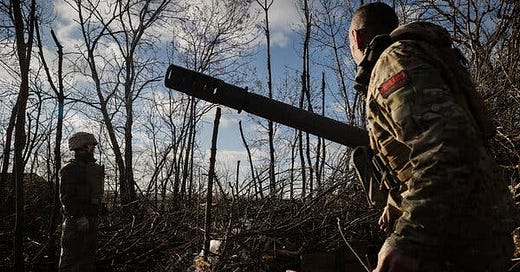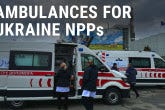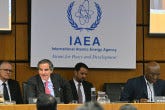LLAW’s All Things Nuclear #815, Friday, (11/22/2024)
NUCLEAR INSANITY: THE LAST DAYS OF HUMAN DEPRAVITY? ~ LLAW
See New York Times story for image description and credits
LLAW’s NUCLEAR NEWS & THE IMPACT ON TOMORROW
Is this the ‘shot across the proverbial bow’ from Putin’s Russia? Or is it just another threat, only this time with destructive ‘bells and whistles’ rather than simply harsh words and political doctrines? Whatever it is, there is no way to concede nor acquiesce to the ultimate purpose of this warning, given that it is intended for not only Ukraine, but the entire free world, particularly including the United States and other NATO countries.
Russia probably believes that this nuclear capable missile carrying conventional weapons of mass destruction may be enough to cause the ‘free world’ countries to discontinue their political and military support of Ukraine, which would mean Russia would easily win the war and rule over Ukraine with an iron fist so to speak. But more than that, I believe that Russia is pretty sure that the U.S. will bow out of military support for Ukraine as soon as Donald Trump takes office, allowing Putin to rule over Ukraine by default rather than using either conventional or nuclear weapons to seek the ‘spoils of war’ over Ukraine without extending the present war.
But the question is, do we walk away from Ukraine’s Democracy, or would the next Russian war target be pointed directly at the United States unless Trump hands over Ukraine as he has been wont to do since before Putin’s re-invasion after Trump lost the previous presidential election, allowing the U.S. to continue Ukraine war support. Trump would most likely “give” Ukraine back to Russia, as he apparently wanted to do before while he was still President, in order to avoid Putin’s direct conflict with Ukraine at the time, but that didn’t happen of course when he lost the previous election to Joe Biden. ~llaw
With Use of New Missile, Russia Sends a Threatening Message to the West
The intermediate-range missile did not carry nuclear weapons, but it is part of a strategic arsenal that is capable of delivering them.
By Marc SantoraLara JakesValerie HopkinsAndrew E. Kramer and Eric Schmitt
Reporting from Kyiv, Ukraine
Nov. 21, 2024
President Vladimir V. Putin escalated a tense showdown with the West on Thursday, saying that Russia had launched a new intermediate-range ballistic missile at Ukraine in response to Ukraine’s recent use of American and British weapons to strike deeper into Russia.
In what appeared to be an ominous threat against Ukraine’s western allies, Mr. Putin also asserted that Russia had the right to strike the military facilities of countries “that allow their weapons to be used against our facilities.”
His warning came hours after Russia’s military fired a nuclear-capable ballistic missile at Ukraine that Western officials and analysts said was meant to instill fear in Kyiv and the West. Though the missile carried only conventional warheads, using it signaled that Russia could strike with nuclear weapons if it chooses.
“The regional conflict in Ukraine, previously provoked by the West, has acquired elements of a global character,” Mr. Putin said in a rare address to the nation. “We are developing intermediate- and shorter-range missiles as a response to U.S. plans to produce and deploy intermediate- and shorter-range missiles in Europe and the Asia-Pacific region.”
Mr. Putin has frequently wielded the threat of nuclear weapons to try to keep the West off balance and stem the flow of support to Ukraine. But sending an intermediate-range missile with nuclear capabilities into Ukraine and brandishing the strike as a threat to the West ratcheted up tensions even further.
Sounding by turns boastful and threatening, Mr. Putin called Thursday’s missile strike a successful “test” of a new intermediate-range ballistic missile called the Oreshnik. And he made clear that the attack on Ukraine was in response to a recent decision by the Biden Administration to grant Ukraine permission to use American-made ATACMS ballistic missiles to hit targets inside Russia.
Ukraine used ATACMS and the British Storm Shadow missile against Russia for the first time this week, Ukrainian and Western officials said.
Since Mr. Putin ordered his troops to invade Ukraine in February 2022 — and Ukraine’s western allies began supplying Kyiv with weapons and other support — both Russia and the West have taken pains to avoid a direct confrontation that all sides agreed could lead to a disastrous military conflict, and possibly nuclear war.
But as the war in Ukraine approaches the end of its third year, the guardrails preventing such a confrontation appear to be under strain like never before.
“This is an escalation,” said Tatiana Stanovaya, a senior fellow at the Carnegie Russia Eurasia Center. “I really believe the situation is very dangerous.”
In his nightly address, President Volodymyr Zelensky of Ukraine said, “Putin is the only one who started this war, a completely unprovoked war, and who is doing everything to keep the war going for more than a thousand days.”
He called the missile strike “yet another proof that Russia definitely does not want peace.”
The use of an intermediate-range missile drawn from Russia’s strategic arsenal was notable, Ukrainian and Western officials said. The target inside Ukraine was well within the range of the conventional weapons that Moscow has routinely used throughout the war.
But this time, Russia launched a longer-range missile capable of carrying nuclear warheads that is mainly intended as nuclear deterrence; that choice, the officials and military analysts said, signals a warning aimed at striking fear into Kyiv and its allies.
Fabian Rene Hoffmann, a weapons expert at the University of Oslo, said that from a Russian perspective, “what they would like to tell us today is that ‘Look, last night’s strike was nonnuclear in payload, but, you know, if whatever you do continues, the next strike might be with a nuclear warhead.’”
There was initially debate on Thursday over exactly what Russia fired at Ukraine. Ukraine’s air force along with Mr. Zelensky initially claimed it was an intercontinental ballistic missile, a weapon capable of hitting targets thousands of miles away, including in the United States. Ukrainian officials said the missile struck a military facility in the central Ukrainian city of Dnipro, though the extent of the damage was not immediately clear.
Senior U.S. officials and a Ukrainian official, however, said the weapon appeared to be an intermediate-range ballistic missile, not an ICBM.
Dimitri S. Peskov, the Kremlin spokesman, said that under protocol, Russia was not required to notify the American side in advance of the missile launch because the Oreshnik is not an intercontinental missile. But an automatic notification to the U.S. was triggered 30 minutes before the launch, Mr. Peskov told Tass, the Russian state media outlet.
The U.S. Department of Defense confirmed that it received that warning.
In a statement on Thursday, the National Security Council in the U.S. said that Russia launched what it called “an experimental medium-range ballistic missile against Ukraine.” The statement said Russia likely had “only a handful” of these missiles and had likely used it to try to “intimidate Ukraine and its supporters.”
The Ukrainian Air Force said the missile was launched from the Russian region of Astrakhan. Ivan Kyrychevskyi, a military analyst with Defense Express, a Ukrainian consulting agency, said the launch area suggested it was fired from a truck based at the Kapustin Yar training range — a Cold War-era testing ground for Soviet ballistic missiles, strategic bombers and other weaponry, underscoring the threat intended with the launch.
Ukraine has no radars capable of detecting such missiles in flight through the upper atmosphere, nor does it have air defense systems capable of shooting them down, Mr. Kyrychevskyi said. “Our Western partners might have seen this launch before us,” he said.
Analysts said the name Mr. Putin gave for the new weapon, Oreshnik, appeared new, but that the weapon itself was likely not much different from known versions of Russian intermediate-range ballistic missiles.
Although other Russian missiles that have been launched into Ukraine can also carry nuclear weapons — like the Iskander and the Kh-101 — what makes the intermediate-range missile alarming, in addition to its range, is its ability to fire multiple nuclear warheads when it re-enters the earth’s atmosphere, said Tom Karako, director of the missile defense project at the Center for Strategic and International Studies in Washington.
That makes it difficult, if not nearly impossible, to intercept them. The missiles are also large and can fly far, high and fast, reaching hypersonic speed.
It represents “a nuclear saber-rattling for both Ukraine and Europe itself,” Mr. Karako said. “It’s a pretty sharp signal.”
Roman Kostenko, the chairman of the defense and intelligence committee in Ukraine’s Parliament, said that Thursday’s attack would not prompt Ukraine to alter how it is fighting the war, including striking back at targets in Russia in self-defense.
But Ukraine halted its nuclear missile production after gaining independence in 1991, and now, Col. Kostenko said, “we have nothing to answer to this class of weapons.”
If there was any doubt about Russia’s intent, Mr. Putin laid out the threat explicitly.
“We have always preferred — and are still ready — to resolve all contentious issues by peaceful means,” he said. “But we are also ready for any development. If anyone still doubts this, it is in vain. There will always be a response.”
On top of everything else, Russian and Western officials have sparred over who is to blame for the recent spate of escalation. While the Kremlin blames Washington for granting Ukraine permission to strike Russian targets with Western weapons, the White House has said Russia’s own actions brought about the decision, specifically citing Russian’s decision to invite thousands of North Korean troops to help dislodge a Ukrainian occupation of part of Russia’s Kursk region.
Karine Jean-Pierre, the White House press secretary, told reporters on Thursday that “the escalation at every turn, at every step, is coming from Russia.”
She repeated the White House’s position that the decision to bring North Korean troops into the conflict was the important escalatory action, and that changes in policy about U.S. weapons were not. “This is their aggression: not Ukraine’s, not ours,” she said.
In Dnipro, at the site of Thursday’s missile strike, officials were still evaluating the extent of the damage of the missile strikes, though it did not appear to be extensive. The city’s mayor, Borys Filatov, wrote on Facebook that an explosion had broken windows at a rehabilitation center for disabled people.
The Ukrainian government does not provide damage assessments of attacks directed at strategic military assets, but local residents suggested the PA Pivdenmash Machine-Building Plant was struck. The precise work that now takes place at the plant is a closely guarded secret, but its history as a missile producer in the Cold War is well known, making it a frequent target for attacks throughout the war.
Michael Schwirtz, Aritz Parra, Oleg Matsnev Maria Varenikova, Nataliia Novosolova and Liubov Sholudko contributed reporting.
Marc Santora has been reporting from Ukraine since the beginning of the war with Russia. He was previously based in London as an international news editor focused on breaking news events and earlier the bureau chief for East and Central Europe, based in Warsaw. He has also reported extensively from Iraq and Africa. More about Marc Santora
Lara Jakes, based in Rome, reports on diplomatic and military efforts by the West to support Ukraine in its war with Russia. She has been a journalist for nearly 30 years. More about Lara Jakes
Valerie Hopkins covers the war in Ukraine and how the conflict is changing Russia, Ukraine, Europe and the United States. She is based in Moscow. More about Valerie Hopkins
Andrew E. Kramer is the Kyiv bureau chief for The Times, who has been covering the war in Ukraine since 2014. More about Andrew E. Kramer
Eric Schmitt is a national security correspondent for The Times, focusing on U.S. military affairs and counterterrorism issues overseas, topics he has reported on for more than three decades. More about Eric Schmitt
ABOUT THE FOLLOWING ACCESS TO “LLAW’S ALL THINGS NUCLEAR” RELATED MEDIA”:
(Please note that the Saturday and Sunday NUCLEAR WORLD’S NEWS — unedited —are added to Monday news posts in order to maintain continuity of nuclear news as well as for research for the overall information provided in “LLAW;s All Things Nuclear”.)
There are 7 categories, with the latest addition, (#7) being a Friday weekly roundup of IAEA (International Atomic Energy Agency) global nuclear news stories. Also included is a bonus non-nuclear category for news about the Yellowstone caldera and other volcanic and caldera activity around the world that play an important role in humanity’s lives. The feature categories provide articles and information about ‘all things nuclear’ for you to pick from, usually with up to 3 links with headlines concerning the most important media stories in each category, but sometimes fewer and occasionally even none (especially so with the Yellowstone Caldera). The Categories are listed below in their usual order:
All Things Nuclear
Nuclear Power
Nuclear Power Emergencies
Nuclear War
Nuclear War Threats
Yellowstone Caldera (Note: There is one Yellowstone Caldera bonus story available in this evening’s Post.)
IAEA Weekly News (Friday’s only)
Whenever there is an underlined link to a Category media news story, if you press or click on the link provided, you no longer have to cut and paste to your web browser, since this Post’s link will take you directly to the article in your browser.
A current Digest of major nuclear media headlines with automated links is listed below by nuclear Category (in the above listed order). If a Category heading does not appear in the daily news Digest, it means there was no news reported from this Category today. Generally, the three best articles in each Category from around the nuclear world(s) are Posted. Occasionally, if a Post is important enough, it may be listed in multiple Categories.
TODAY’S NUCLEAR WORLD’S NEWS, Friday, (11/22/2024)
All Things Nuclear
NEWS
Russia hit Ukraine with new mid-range ballistic missile, Putin says - CNN
CNN
In the past, MIRVS were “exclusively for nuclear warheads, and everything that's more tactical is either singular or cluster muntions,” Karako told ...
United Nations nuclear agency again condemns Iran for failing to fully cooperate - KNPR
KNPR
All Things · Culture · Food and Drink · The Guide · All Things · Culture · Food and ... nuclear material, and grant access to IAEA inspectors to all ...
New eyes on nuclear: Technology industry reps, investment bankers visit INL to learn about ...
Newswise
... nuclear power plants to generate electricity. “Public perception is now at an all-time high, and has been stable for the last few years,” Wagner said.Nuclear Power
Nuclear Power
NEWS
Nuclear Energy Prevents Air Pollution and Saves Lives - Reason Magazine
Reason Magazine
This article originally appeared in print under the headline "Nuclear Power Saves Lives." Start your day with Reason. Get a daily brief of the most ...
Nuclear plant asks regulators to reconsider rejected expansion - Energy News Network
Energy News Network
NUCLEAR: Talen Energy asks federal regulators to reconsider their rejection of a plan to scale up capacity at a Pennsylvania nuclear plant to ...
The Nuclear Option: Unleashing America's Energy Future - The Daily Signal
The Daily Signal
The incoming Trump administration to bolster America's energy independence, and nuclear energy has the potential to transform our future.
Nuclear Power Emergencies
NEWS
Federal inspectors returning to Palisades nuclear plant next month - MLive.com
MLive.com
Communities around closed nuclear plant can expect return of radiation emergency exercise in July.
Russian attacks on NPP substations: Ukraine urges IAEA to take more drastic measures
Ukrinform
“Blackout or emergency shutdown of nuclear power plants is their top priority. Consequently, the risks of any nuclear accident are incredibly high ...
Emergency Blackout In Kyiv After Russia's ICBM Attack On Ukraine | Details - Times of India
Times of India
... emergency power cuts across several regions following the escalation of attacks. Watch.
Nuclear War
NEWS
DOD Adjusts Nuclear Deterrence Strategy as Nuclear Peer Adversaries Escalate
Department of Defense
Multiple nuclear peer adversaries challenge the security of the U.S. and its allies and partners, according to the Defense Department.,
North Korea's Kim accuses US of stoking tension, warns of nuclear war, KCNA says
Reuters
North Korean leader Kim Jong Un has accused the United States of ramping up tension and provocations, saying the Korean peninsula has never faced ...
Ukraine war: After days of escalation, what will Russia's Putin do next? - BBC
BBC
After all, this was the week the Kremlin leader lowered the threshold for the use of Russian nuclear weapons. It was the week the US and UK crossed ( ...
Nuclear War Threats
NEWS
Vladimir Putin fires a new missile to amplify his nuclear threats - The Economist
The Economist
On the same day, Ukrainian lawmakers were warned that the country's parliament building in Kyiv was at risk of Russian missile attack. These threats ...
Russia-Ukraine war sees another 'dangerous cycle' as threats escalate - Sky News
Sky News
Russia-Ukraine war sees another 'dangerous cycle' as threats escalate ... Putin's latest threat is a declaration that the US is risking nuclear war with ...
Putin Escalates Threats to the West With New Ballistic Missile Launch - The New York Times
The New York Times
In what appeared to be an ominous threat against Ukraine's western allies, Mr. Putin also asserted that Russia had the right to strike the military .
Yellowstone Caldera
NEWS
7 US States With Active Volcanoes Near Cities - TheTravel
TheTravel
Active volcano near cities: Yellowstone Caldera. Close. There's only ... The Yellowstone Caldera is a supervolcano and a volcanic caldera that ...
IAEA Weekly News
22 November 2024
See the top stories from this week's IAEA Board of Governors meeting in Vienna, and as COP29 draws to a close in Baku, explore our COP29 Blog for in-depth coverage of the role of nuclear science and technology in the global climate discussions.
22 November 2024
Harnessing Nuclear Technology in the Service of Humankind — Together
Kai Mykkänen, Minister of Climate and the Environment of Finland and the co-chair of the IAEA's upcoming 2024 Ministerial Conference on Nuclear Science, Technology and Applications and the Technical Cooperation Programme, discusses the conference's significance and how nuclear science and technology helps provide solutions to global challenges. Read more →
21 November 2024
IAEA Joins UN Organizations at COP29 in Calling for Increased Collaboration to Reach Climate Goals
Heads of UN agencies endorsed South-South cooperation and inter-agency collaboration as critical for climate action at a High-level Forum on this topic hosted by China at the 29th UN Climate Change Conference (COP29). The IAEA joined them in promoting South-South cooperation as a valuable mechanism to help achieve climate action goals in an equitable manner. Read more →
21 November 2024
IAEA Delivers Ambulances to Ukrainian Nuclear Sites
The International Atomic Energy Agency has handed over two new, fully equipped ambulances to Ukraine this week, providing vital medical support to the people working at its nuclear facilities. Read more →
20 November 2024
Director General Briefs Board on Iran Developments, Ukraine Support, Technical Assistance and More
The IAEA Director General has briefed the Board of Governors on his high-level meetings in Tehran last week, describing his discussions with the new government as constructive. Nevertheless, he pointed out, there were ongoing concerns. Read more →
18 November 2024
Nuclear Power in the COP29 Spotlight as Countries and Companies Eye Climate Solutions
Nuclear power is in the spotlight at the United Nations Climate Change Conference (COP29) in Azerbaijan, where both countries and industries presented plans to deploy the carbon-free energy technology, building on the historic consensus to accelerate its use that emerged from last year’s climate summit. Read more →
18 November 2024
IAEA Director General Receives Nuclear Statesman Award
The IAEA Director General has been granted a major honour – the Henry DeWolf Smyth Nuclear Statesman Award – for outstanding service in developing and guiding the peaceful uses of nuclear energy. Read more →













